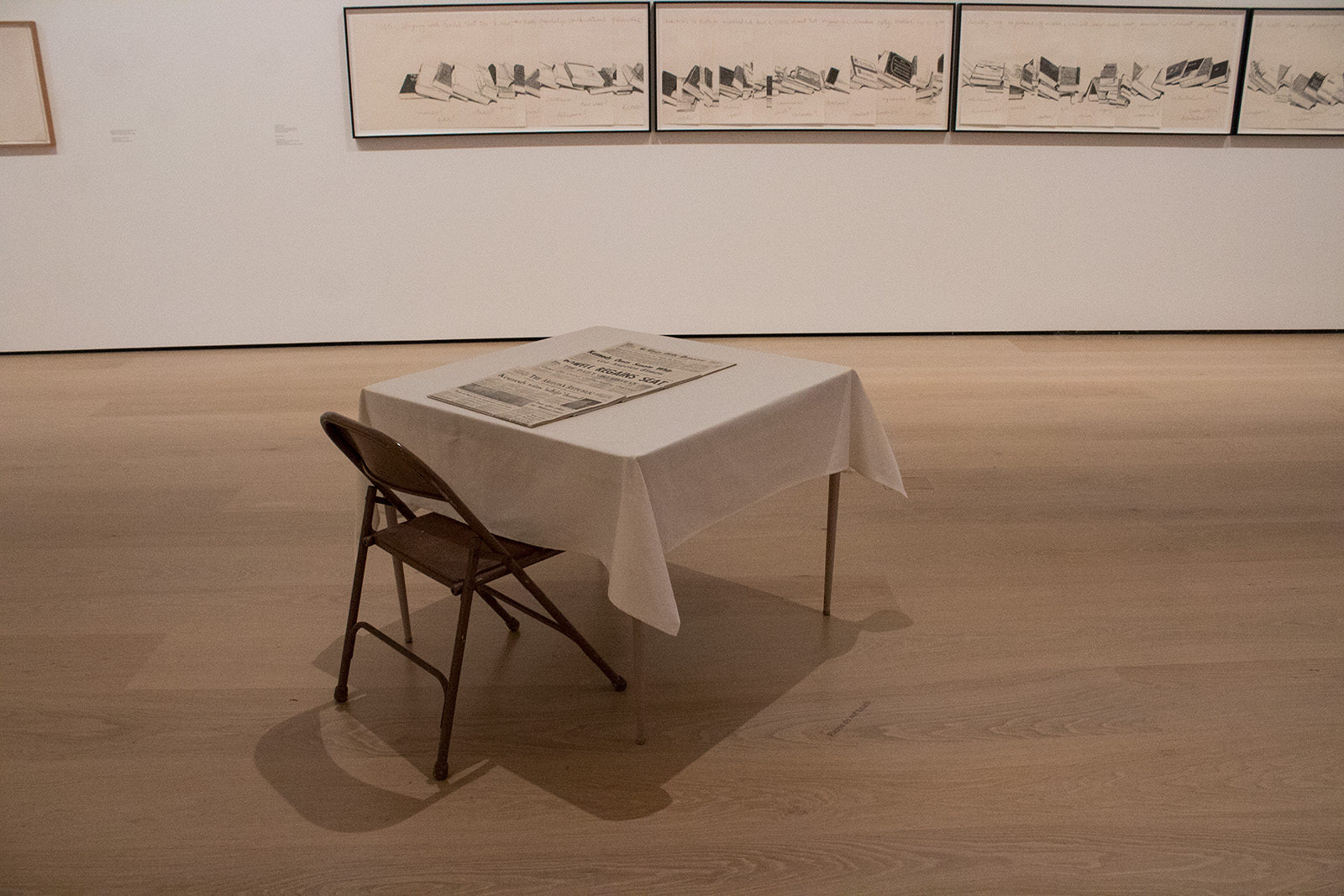Art to Heart: Close encounters with contentious art challenge long-held conceptions, definitions

An empty chair at a table with an open newspaper is an installation at the Hammer Museum. For this week’s “Art to Heart,” columnist Lisa Aubry visited the museum and watched as visitors observed the installation. (Lisa Aubry/Daily Bruin)
By Lisa Aubry
April 24, 2019 10:20 p.m.
Art, the universal language, can transcend space and time to reach a diverse audience. We hear this all the time, but do we truly feel the weight of these words? A cloud of elitism envelops the “art world,” alienating the perspectives of some while glorifying those of others. In efforts to challenge ideas that reinforce the intrinsic validity of one individual’s take on art over another’s, columnist Lisa Aubry will explore different creative spaces and outlooks on art and reconcile the fields of arts and sciences through discussions.
“Excuse me, sir, this artwork is not interactive.”
I watched as the Hammer Museum docent delivered the warning through a smile that did not compromise her tonal firmness. The art must, after all, be protected. The surprised but compliant visitor wandered away from the installation of an empty chair at a table with an open newspaper on it. The gallery’s silent lull returned.
Watching this interaction, I realized museums must master and maintain a delicate balance of duties: encouraging mental connection to artworks while also ensuring their physical protection. Part of the task involves showing visitors that any responses to artwork, whether they be agreement or disapproval, are valuable; their emotional reactions or intellectual rebuttals signal the potency of the ideas within the artwork. During my visit to the Hammer Museum, I spoke with Hayley Miller, a visitor experience student lead who is well-acquainted with the strategies for striking this important balance.
Miller, a fourth-year communication and art history student, said it all comes down to prompting conversations that go beyond standard formalities, prodding visitors toward verbal expression. The goal is to immediately establish an atmosphere in which visitors feel comfortable to ask questions or offer their opinions.
“The Hammer – being more accessible than a lot of other museums because it’s free – ends up attracting a much more diverse crowd of people from different backgrounds and art knowledge,” Miller said. “A big part about facilitating the positive experience from our end is to be prepared to engage with any type of person that walks through the door without falling into superficial or cookie-cutter customer service.”
[RELATED: Art to Heart: Art helps physicists comprehend, communicate fundamental principles of the universe]
I noticed this genuine spirit during my visit when the front desk worker asked me how I was doing and followed up with, “Are you looking forward to seeing the artwork today?” The check-in is the first exchange the visitor will have in the museum setting and hence, it sets a precedent for their experience within the galleries. On my way up the marble staircase toward the galleries, another worker invited me to attend some of the week’s programs – a Q&A about sex therapy, a concert of classical Armenian music and a session on mindful meditation.
But initial interactions with visitors aren’t always so pleasant, Miller said. Because of their provocative and controversial nature, some contemporary art pieces tend to elicit polarizing reactions. Miller recalled an instance when she asked a visitor not to touch the art, to which he crisply responded that it didn’t matter because it was not artwork.
Contrary to what she believed in her first days as a gallery docent, Miller said no one is expected to revere or connect with every artwork on display – or pretend to do so for the sake of appearing hip and open. Nonetheless, it is important to maintain a basic level of respect for the physical makeup of each piece and prevent destructive reactions. The distinction between reverence and respect for artworks is a tool that can help banish the elitism of art viewing some visitors may sense.
“I can remember quite a few times when I heard the classic, ‘A 5-year-old could do this,’ or the eye-roll and, ‘You can’t be serious – this is art?’” she said. “But I’ve found that the most memorable and meaningful conversations with visitors for me have started with a conflict.”
[RELATED: Hammer’s ‘wasteland’-themed Arts Party considers material reuse, artistic inspiration]
In these cases, Miller said it is best to maintain an open dialogue through which the museum worker can share their own honest opinions or use the visitor’s passionate response about an artwork to jump-start a constructive conversation. This leads to questions like, “What is art? What does it mean to me, what does it mean to you, and what does it mean to the institution?”
“By providing an outlet for visitors to be transparent in expressing their feelings or thoughts, we are trying to break down some of the elitism about viewing artwork,” she said. “In my own experience, that’s something that I’ve found rarely in other museum settings.”
When visitors confront pieces they deem controversial or flagrantly unattractive, Miller said she noticed some of them grow uncomfortable or upset. Yet the sense of discomfort challenges the visitor to think critically about the artwork by either questioning or reaffirming their own values and beliefs in relation to it. The exercise of expanding one’s mentality necessarily calls for some growing pains. But you know what they say – no pain, no gain.
“I think apathy is probably one of the greatest threats to museums and art appreciation in general,” Miller said. “Having any interest, positive or negative, in the art is ultimately a good thing, and it brings the art alive.”
Whether admiring a particular shade of purple, clicking with a sculpture’s message or recoiling from a painting and questioning its purpose, time spent in museums is never lost. Open-mindedness and honest discussion remain key methods for unlocking a range of new insights about the world through artwork.

